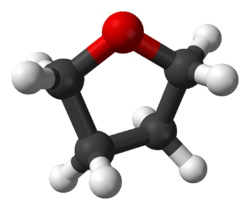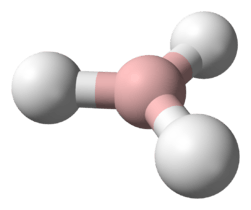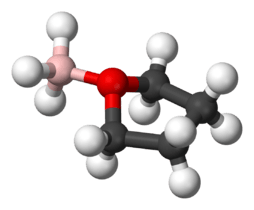Adduct
An adduct (from the Latin adductus, "drawn toward" alternatively, a contraction of "addition product") is a product of a direct addition of two or more distinct molecules, resulting in a single reaction product containing all atoms of all components.[1] The resultant is considered a distinct molecular species. Examples include the addition of sodium bisulfite to an aldehyde to give a sulfonate. It can just be considered as a single product resulting from direct addition of different molecules and constitutes all the reactant molecules' atoms.
Adducts often form between Lewis acids and Lewis bases.[2] A good example is the formation of adducts between the Lewis acid borane and the oxygen atom in the Lewis bases, tetrahydrofuran (THF): BH3·O(CH2)4 or diethyl ether: BH3·O(CH3CH2)2.
Compounds or mixtures that cannot form an adduct because of steric hindrance are called frustrated Lewis pairs.
Adducts are not necessarily molecular in nature. A good example from solid-state chemistry is the adducts of ethylene or carbon monoxide of CuAlCl4. The latter is a solid with an extended lattice structure. Upon formation of the adduct, a new extended phase is formed in which the gas molecules are incorporated (inserted) as ligands of the copper atoms within the structure. This reaction can also be considered a reaction between a base and a Lewis acid with the copper atom in the electron-receiving role and the pi electrons of the gas molecule in the electron-donating role.[3]
Adduct ions
An adduct ion is formed from a precursor ion and contains all of the constituent atoms of that ion as well as additional atoms or molecules.[4] Adduct ions are often formed in a mass spectrometer ion source.
See also
References
- IUPAC, Compendium of Chemical Terminology, 2nd ed. (the "Gold Book") (1997). Online corrected version: (2006–) "adduct". doi:10.1351/goldbook.A00138
- Housecroft, Catherine E.; Sharpe, Alan G. (2008). "Acids, bases and ions in aqueous solution". Inorganic Chemistry (3rd ed.). Harlow, Essex: Pearson Education. p. 199. ISBN 978-0-13-175553-6.
- Capracotta, M. D.; Sullivan, R. M.; Martin, J. D. (2006). "Sorptive Reconstruction of CuMCl4 (M = Al and Ga) upon Small-Molecule Binding and the Competitive Binding of CO and Ethylene". Journal of the American Chemical Society. 128 (41): 13463–13473. doi:10.1021/ja063172q. PMID 17031959.
- IUPAC, Compendium of Chemical Terminology, 2nd ed. (the "Gold Book") (1997). Online corrected version: (2006–) "adduct ion (in mass spectrometry)". doi:10.1351/goldbook.A00139


